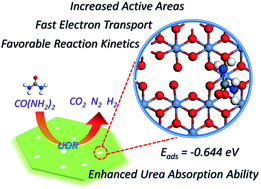Ultrathin nickel hydroxide nanosheets with a porous structure for efficient electrocatalytic urea oxidation†
Abstract
The direct urea fuel cell (DUFC) is a renewable technology for energy production, but largely limited by the intrinsically sluggish kinetics of the urea oxidation reaction (UOR) due to the complex six-electron transfer process, which severely hampers its commercial utilization. Herein, ultrathin β-Ni(OH)2 nanosheets with a porous structure were constructed to increase both the active surface area and the reactivity of active sites of catalysts, providing great opportunities for promoting the electrocatalytic UOR process. Theoretical investigations showed that the existence of abundant pores in ultrathin β-Ni(OH)2 nanosheets could reduce the adsorption energy of urea molecules on the catalyst surface, thus leading to a highly efficient catalytic activity for the UOR. As expected, the porous β-Ni(OH)2 nanosheets exhibit a large current density of up to 298 mA cm−2 at 1.82 V (vs. RHE), which is roughly 18.1 times higher than that of the nonporous β-Ni(OH)2 nanosheets and even comparable to those of other high-performance catalysts under similar conditions. This work not only provides a promising guideline for the development of advanced UOR catalysts, but also highlights the crucial role of the porous structure in promoting the electrocatalytic UOR process.



 Please wait while we load your content...
Please wait while we load your content...